Giant pandas are creatures that go beyond the meaning of the word cuteness.
Who wouldn’t recognize them? Their black and white fur is so distinctive that you can spot them from afar.
Are you interested to know more about them? Here are the 29 giant panda fun facts that may surprise you.
Read on below for more fun facts!
1. Pandas belong to the bear family.

Do you know the American animated children’s television series We Bare Bears? The main characters there are Grizzly, Ice Bear, and Pan-Pan.
They derived them from real animals like grizzly bears, polar bears, and panda bears. Moreover, they belong to the same family in real life; the Ursidae family (scientific name).
2. They are born tiny and pink.

A newborn panda cub is tiny, pink, hairless, and blind. It has a small body that is approximately around 1/900th the size of its mother.
The giant panda newborns are the smallest mammal babies compared with their mother’s size.
Also, they look so different from their parents. They resemble the appearance of a newborn baby rabbit or rat.
3. Pandas mainly feed on bamboo.

Giant pandas in the wild often stay in areas where there is a large understory of bamboo, also known as bamboo rainforests.
Bamboos are tall grasses. Unlike other grasses, there are only a few animals that feed on this type of grass. These include giant pandas, red pandas, and a few others.
Due to the lack of competition, giant pandas rely on this grass as a food source.
4. Pandas are adorable.

Edgar E. Coons, a behavioral neuroscientist, believes that we find pandas so cute because of the “hedonic mechanisms” their features trigger in us.
They seem like cuddly toys because they are big and fluffy. Panda babies also remind us of human babies because of their physical appearance and behaviors.
These reasons lead our brains to tell us that they are indeed fun to watch.
RECOMMENDED READING: WHY DO GIANT PANDAS HUG LEGS?
5. They poop 40 times a day.
Giant pandas poop up to 40 times a day that weighs around 28 kilos. The primary food source of pandas is bamboo, but it lacks nutrients.
For this reason, they tend to eat a lot of it to make up for the lack of nutrients in their diet. So, it is not surprising that pandas spend most of their time eating bamboo.
They poop bamboo that they cannot fully digest from time to time.
Recommended Reading: Do Giant Pandas Fart A Lot?
6. Pandas have the habit of rolling.
One of the most endearing fun gimmicks of giant pandas is when they roll around on the ground.
Yes, they curl up like balls and roll their bodies. Pandas are so cute that our brains tell us we want to catch them when they do it. They usually do this like it is a part of their daily routine.
7. They can eat meat too.
Although they are herbivores that are so dependent on bamboo, the giant pandas can also eat meat.
Studies have shown that they have the same digestive system characteristics as wolves. They occasionally hunt and eat pikas and other small rodents.
They do this because the bamboo does not have enough nutrients that they need.
8. Panda mothers are very caring.
Considering that giant pandas are also mammals, they do what human mothers do. They protect and take care of their children.
Panda mothers feed them by breastfeeding just like humans and all other mammals. They have mammary glands.
These glands can produce milk that serves as food for their babies.
9. They are the symbol of conservation.

Giant pandas have been the symbol of conservation for many years. They are the logo of the world-famous organization WWF or World Wildlife Funds.
In the past years, they were among the endangered species, and WWF and other non-profit organizations did their best to preserve their existence.
Now, they are no longer among the endangered species, but they are still vulnerable.
10. Pandas live in the temperate rainforest.

One of the distinctive features of giant pandas is that they naturally live in temperate rainforests. These rainforests are cool in temperature.
Like all other rainforests, they are with an extensive canopy of evergreen trees.
The giant panda is an endemic animal, meaning it naturally exists in the rainforests found in the Min and Qin mountain ranges of Central China.
11. They are the national treasures of China.
The Chinese government considers giant pandas as their national treasures simply because they are endemic to China.
Panda lovers visit China just for the chance to hold and cuddle giant pandas and their cubs. These cuddly creatures can contribute to tourism in China.
Tourists and fans even spend money on them, which helps the finances of China.
RECOMMENDED READING: WHY ARE PANDAS CALLED PANDAS?
12. Lead role in Kung Fu Panda.

Kung Fu Panda is one of the most famous movies in history where a giant panda is the main character.
It tells the story of an adopted giant panda who eventually turns to be the main hero who fights the bad guys.
The movie is what people usually think about when they hear the word giant pandas.
13. Pandas often destroy trees.
Despite the large body size of giant pandas, they are good tree climbers. They climb trees, even the thinnest branch like they have a small and slender body.
Since they are so big, they often destroy the tree branches and hurt themselves when they fall.
Nonetheless, they look so cute when they sit on the top of the trees while swinging their feet.
14. They are good swimmers.
Yes, they are not only good tree climbers but also great swimmers. They often swim in the waters found in the temperate rainforest where they live. Despite their body size, they know how to balance themselves in the water and paddle with their arms and legs. They love to play in the water, just like a child who loves a swimming pool.
15. They love to lick copper and iron.
Giant pandas are known for their crazy antics. And this is one of the strangest things giant pandas do. They love to lick copper and iron.
These are the studies and observations of the experts who take care of the giant pandas while they live in captivity. However, it is still unknown why they do this.
16. Pandas are for rent.
Due to the rarity of giant pandas in recent years, the Republic of China prohibits the selling and buying of giant pandas.
However, the Chinese government has allowed other countries to keep giant pandas in their zoos or animal breeding centers by renting them.
Yes, they are available for rent. It comes with a hefty price tag of one million dollars per year for each giant panda.
17. Panda cubs rely on their mothers.
Giant panda cubs are so dependent on their mothers. They can’t even eat or poop by themselves.
Due to the helplessness of giant panda cubs and their low chances of survival, the Chinese government even hires caregivers.
With this strategy, the low survival rate of giant pandas can increase.
18. They are talkative.
Among the bear family, the giant panda is the most talkative. They use a wide variety of sounds to greet each other.
The most common of these is a bleating sound, somewhat similar to the sounds made by lambs and baby goats.
Pandas produce sounds like honks, growls, barks, and huffs, while panda cubs like to croak and squeal. They can even communicate through scents.
Recommend Reading: How Do Giant Pandas Communicate
19. Pandas could be dangerous.
No matter how cute they are in the videos you’ve seen, never approach a giant panda in the wild. Just like any other wild animal, they may attack when they sense discomfort or danger. Be very vigilant because their sharp paws and firm bites are enough to cause you serious harm.
20. There’s an all-white panda.
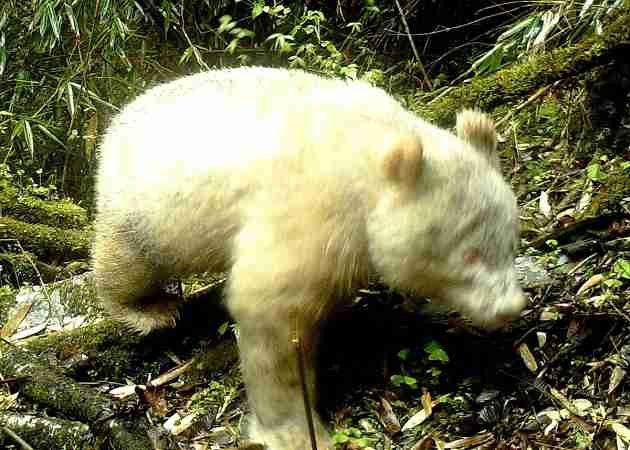
Albinism is a genetic condition in which living creatures are born without the usual pigment (color) in their bodies that makes them white.
It is probably one of the rarest pandas you will ever see. And for the record, it is the only albino panda seen in history.
It was captured by an infrared camera while roaming in its natural habitat in Wolong, Southwest Sichuan.
ALSO READ: CAN RED PANDAS BE WHITE?
21. There are real brown pandas.
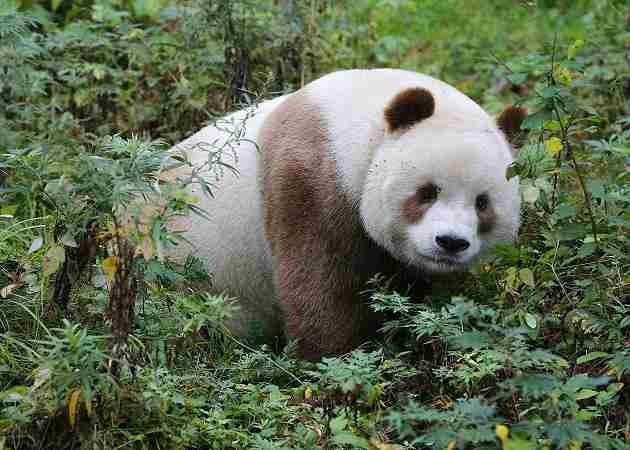
Qinling Pandas are known as brown pandas (Ailuropoda melanoleuca qinlingensis).
They are also the subspecies of the giant pandas. Brown pandas are rare because of their color; they have brown fur instead of black.
There are only nine sightings of them in the wild. One of the most famous brown pandas is probably Qi Zai.
22. Panda cubs can be gray too.
In some cases, giant panda cubs have pale fur that looks like a faded black or gray. However, as they get older, their hair darkens and eventually becomes black like the rest.
People refer to them as “Faded National Treasure.” Most of these gray panda bears are born in the Chengdu Research Base of Giant Panda Breeding.
23. They have existed for millions of years.

People have discovered the teeth of Ailuropoda baconi that lived in the Asian caves 750,000 years ago. The same goes for the skull of Ailuropoda microta from 2 million years ago.
In 2012, some scientists in Spain found teeth from the oldest known direct ancestor of the giant panda, Kretzoiarctos Beatrix. The remains were 11.6 million years old.
24. Pandas can attract zoo visitors.
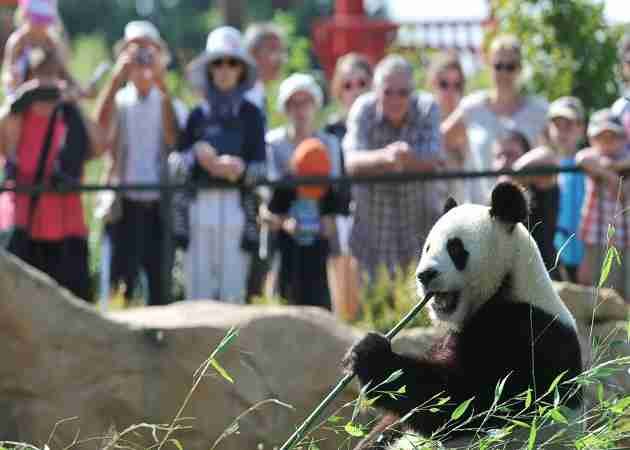
If they cost a lot of money, why do countries still rent pandas? Simply because pandas can attract visitors.
If more visitors come to the zoo or animal center, then there is more money to earn.
The analysis shows that the zoo gains more on a percentage basis with giant pandas than in the years when there are no pandas in the zoo.
25. They love to be alone.
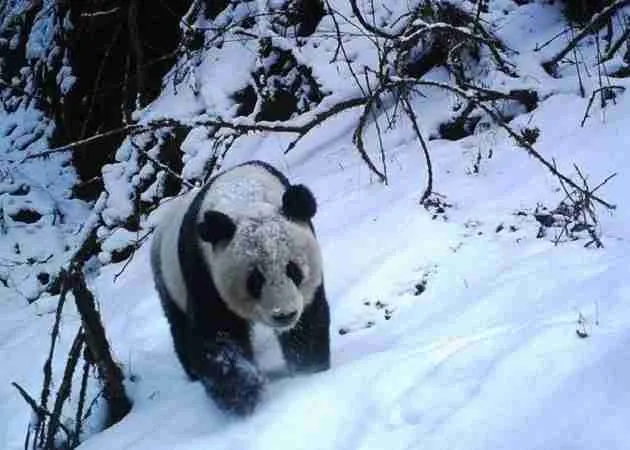
What we see in the zoo or the breeding center does not apply to the wild giant pandas. In captivity, humans nurture pandas.
It is the reason why they develop friendly behavior. However, in the wild, it’s a different story. They usually stay miles away from each other and meet only during mating season.
26. Pandas give birth in August.
If you want to see newborn baby giant pandas, you should visit them in August. But giving birth is not always a good story.
When a panda gives birth to twin babies, it abandons one of its cubs. For the mother panda, it is better to raise a strong one than two weaklings.
The mother panda will leave one cub because it cannot nurture two due to the lack of nutrients in its diet.
27. They are playful.
Giant pandas are playful by nature. In captivity, their playfulness doubles. One of the nanny’s jobs is to send them to school.
Yes, they have their school. They are encouraged to move and play around.
Their school is like a playground where they learn how to use different platforms like slides, swings, and more.
28. They sleep 2-4 hours after eating.
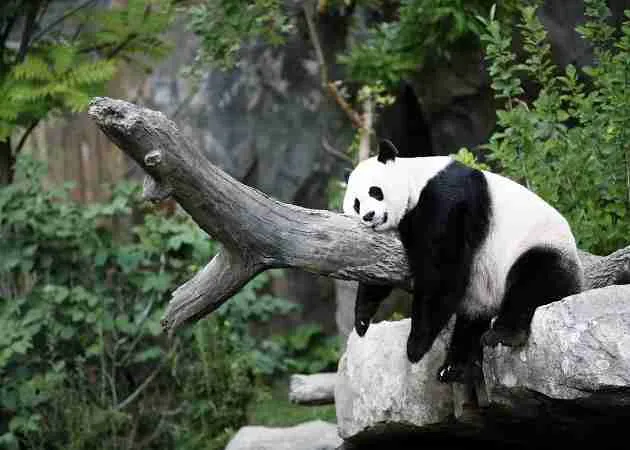
Aside from eating, giant pandas’ favorite activity is sleeping. Yes, it has lazy behavior. But yes, that is their nature.
They sleep for 2-4 hours between two meals. And it is normal to see them sleeping everywhere.
In captivity, they sleep anywhere that drowsiness gets to them. In the wild, they sleep on a forest floor, on a rock, or balancing on a branch.
29. Pandas live longer with humans.
Studies have shown that giant pandas living in captivity under human care live longer than those living in the wild.
The giant panda in the wild lives up to 14 to 20 years, while those living in human care can live up to 30 years if properly cared for and fed.
It seems that these cuddly animals mean to coexist with humans.
Conclusion:
In this article, you have learned so many facts about giant pandas. It is good to know that there are many people like you who are interested in these animals.
It is because they need understanding, love, and respect too.
Just like all other animals, giant pandas have peculiarities too. But what is more important than knowing the differences is knowing what we can do for them.
Let us continue our love for these animals and help them survive in the long run. In this way, the new generation can still witness the beauty of our favorite giant pandas.
What’s your favorite giant panda fun fact?
Let’s spread awareness about pandas and help them in a simple way.

